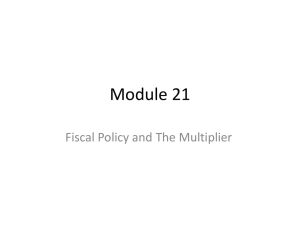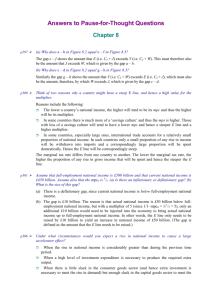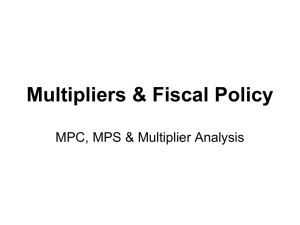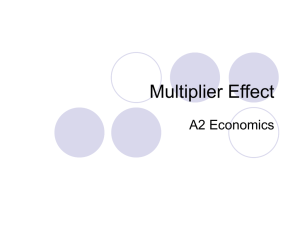The Multiplier Effect
advertisement
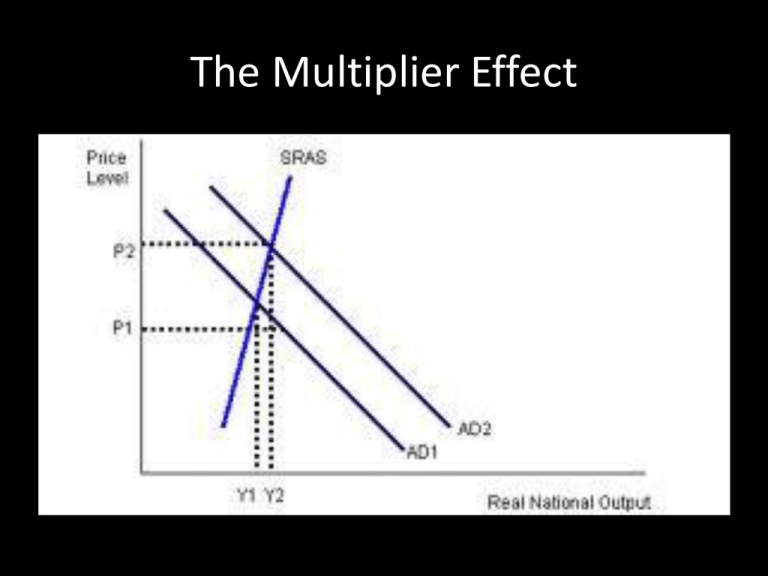
The Multiplier Effect Multiplier Effect • “the impact on real GDP of a change in any of the components of aggregate spending (C, I , G , X-M).” • The multiplier effect results in a larger change in real GDP than the initial change in any of the four components of aggregate spending Mathematically speaking…. Multiplier = change in real GDP/ initial change in expenditure Or… Initial change in expenditure X multiplier = change in real GDP So you’re saying…. • That a $1 increase in spending by C, or I, or G, or X-M might lead to a greater than $1 increase in real GDP? How does that work? It’s like a chain reaction! The Chain Reaction Explained • Suppose I increases by $8,000,000 (autonomous expenditure) . Real GDP goes up by the same amount, but that’s not all that happens. Induced expenditures follow, because the $8,000,000 is also income received by the factors of production, which in turn makes possible increased consumption spending (C) It’s kinda like dominoes… What about leakages? • As we know, increased income that flows to the owners of factors of production isn’t always entirely spent. • A portion of the additional income will be spent (these are injections to the circular flow), but the other portion will be saved (leakages to the circular flow) Marginal Propensity to Consume • MPC is the fraction of additional income that households spend on consumption of domestically produced goods and services. • So if MPC =3/4, and real income increases by $8,000,000…. • how much new consumption will result? • how much will leak out as savings? Marginal propensity to save and friends • MPS (marginal propensity to save) is one of the ways new income can leak from the circular flow. • MPT (marginal propensity to tax) represents how much of new income must be paid in taxes • MPI (marginal propensity to import) represents how much of new income will be spent on imports So if you add ‘em all up…. • MPC + MPS + MPT + MPI = 1 • Makes sense because every $1 of additional income is either consumed, saved, taxed or spent on imports. So let’s do some math • Let’s assume I has increased by $8,000,000. • So the initial increase to income is $8,000,000. Then what happens? Let’s assume the MPC is .75….. Calculating the value of the Multipler Change in income Induced change in consumption 1st round $8,000,000 ¾X8=6 2nd round $6,000,000 ¾ X 6 = 4.5 3rd round $4,500,000 ¾ X 4.5 = 3.38 4th round $3,380,000 ¾ X 3.38 = 2.5 And on and on And on And on….. Total $32,000,000 ¾ X 32 = 24 Initial increase in investment expenditure of $8,000,000 The answer is….. • An increase of $8,000,000 in I will lead to an increase in income (real GDP) of $32,000,000 when MPC = .75. • $8,000,000 of that is from the initial increase in I, the other $24,000,000 comes from the increase in induced consumption spending So the value of the Multipier is…. • Multiplier = Change in real GDP/ initial change in expenditure $32,000,000/$8,000,000 = 4 More relationships… • Multiplier = 1/1-MPC • Multiplier = 1/1-.75 • Multiplier = 1/.25 • Multiplier = 4 • So in order to calculate the multiplier, all we need to know is the marginal propensity to consume Moral of the story…. • The larger the marginal propensity to consume, the larger the value of the multiplier will be. • Increases to any of the components of AD will have the same effect • It works in the opposite way too, decreases in spending will lead to a larger decrease in total income Multiplier effect on AD The multiplier and fiscal policy • Obviously, the value of the multiplier plays an important role in the effect of expansionary or contractionary fiscal policy. If government pursues expansionary fiscal policy, knowing the value of the multiplier will give us a better idea of how much real GDP will actually increase. Tax cuts vs. government spending • Remember that increased government spending will have a greater effect on real GDP than tax cuts. Does anybody remember why this happens? Tax cuts vs. government spending • If the multiplier = 4 (MPC= .75), a $1 increase in government spending leads to $4 in increased AD • If the multiplier = 4 (MPC= .75), a $1 tax cut will lead to $3 in increased AD and $1 in increased savings • Increases in government spending have a greater effect on AD than tax cuts but are less popular Final thoughts on the multiplier • The multiplier is difficult to calculate because: • It takes months for spending to cycle through the economy • Changes to MPS, MPI, and MPT can cause the size of the multiplier to fluctuate Final thought on the multiplier • Beware the effect of the price level! When in the horizontal portion of the Keynesian AS curve, increases in AD will increase output without increasing the price level. However, as we move towards the upwards sloping portion of the Keynesian AS curve, increases in AD will lead to rising price levels and less or no increase in output! Final thought on the multiplier • In the neoclassical short run, increases in AD will lead to both increased output and an increasing price level. In the long run, the vertical AS curve suggests that there will be no multiplier effect, only increases in the average price level Keynes on the multiplier effect “I like it”
